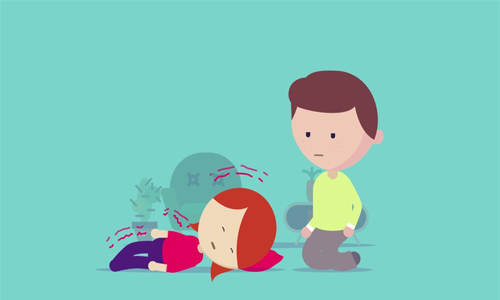Abstract
Typical Hypsarrhythmia is an EEG (electroencephalographic) pattern associated with the epileptic syndrome (west syndrome) that affects children under 1 year of age. Fetal developmental defects and prenatal hypoxic-ischemic complications predominate are common in west syndrome infants. Boys are mostly affected by girls. The EEG pattern usually is observed in children from 3 months to 5 years old, and it can be due to burst-suppression or low-voltage invariant patterns in the newborn period. We have discussed various different points with effective herbal and home remedies.
Introduction To Typical Hypsarrhythmia
Dr. William James West in 1841 wrote a letter to Lancet describing new infantile convulsions in his 4-month-old son. He described events, starting with head drop and progressing to a group of myoclonic spasms occurring multiple times daily, accompanied by regression of development of his previously normal child. His letter also contains the distress of father and medical provider caused by this rare, difficult to treat and frequently, neurologically damaging condition. Over 170 years later, this most common form of infantile epilepsy, but can still be just as distressing and difficult to treat as in the case of Dr. West’s son.
West syndrome is a type of epileptic encephalopathy. It is characterized by a seizure type known as infantile spasms. Spasms may be extensor, nods, flexor, lightening but mostly they are mixed. Spasms usually begin in the first year typically between 4-7 months. Boys are mostly affected by girls. West syndrome is a type of Seizure disorder with unique clinical and Infantile spasms that are one of the childhood epilepsies due to the difficulty of controlling seizures and the association with mental retardation. Infantile spasms syndrome, now it is known as West syndrome, is a triad of clinical flexor or extensor spasms, often involves head/neck, hypsarrhythmia electroencephalogram (EEG) and subsequent intellectual disability.
Hypsarrhythmia refers to the abnormal Electronencephalographic (EEG) pattern notice in infants with epileptic spasms, which is an epileptic encephalopathy that presents in infancy. In infants, epileptic spasm typically presents in the first year of life, with the peak onset at 6 months of age. Classically, the term West Syndrome has been used to describe the epileptic spasms in infants, hypsarrhythmia and developmental regression. Hypsarrhythmia refers to the interictal EEG pattern and based on a visual inspection and it is accompanied by high voltage, asynchronous slow waves with multi-focal spikes, which can be varied according to duration and location. The finding of hypsarrhythmia on EEG is of great concern to pediatric neurologists; it can be associated with poor neurological outcomes. Thus both the resolution of spasms and normalization of EEG are pivotal treatment goals.
Pediatric Neurophysiologic Evaluation
Hypsarrhythmia is the most common interictal EEG pattern linked with infantile spasms. The most common symptom description is sudden, symmetric, tonic muscle contraction. The EEG pattern usually is observed in children from 3 months to 5 years old, and it can be lead by a burst-suppression or low-voltage invariant pattern in the newborn period. It can also be preceded by a normal EEG pattern. During a spasm, an electrodecremental response interrupts the high amplitude slowing by a sudden decrease of all activity with a duration of 1 sec to 1 min. the role of EEG is limited to diagnosis only, with no reliable correlation with course, cause, or prognosis, including mental development.
Epileptic Spasms
The EEG of infantile spasms is hypsarrhythmia, a disorganized interictal pattern consisting of random high voltage slow waves and spikes. The spike discharge is usually multifocal, but when generalized, they are never rhythmically repetitive. Hypsarrhythmia is often present during awake and quiet sleep and may be reduced or even absent during active sleep. Other EEG patterns including modified hypsarrhythmia or multifocal spikes can also be seen in children suffering from infantile spasms.
Children with severe brain abnormalities such as tuberous sclerosis and Aicardi syndrome may not usually generate the typical hypsarrhythmic pattern. Asymmetric hypsarrhythmia may show the presence of a focal CNS lesion. Specific pattern, any significant EEG background abnormality in a patient with clinical spasms may contribute to the epileptic encephalopathy, and all patterns should be viewed equally when considering an approach to treatment.

West Syndrome
West syndrome can be characterized by a group of spasms and hypsarrhythmia on EEG and may be observed at the onset. West syndrome often shows atypical features: epileptic spasms may be more prolonged and may be associated with focal, often subtle, seizures or with other paroxysmal motor events, such as isolated or repetitive jerks, and sustained tonic phenomena. The hypsarrhythmic pattern on the EEG tracing often shows a variant with prominent slow activity with few epileptic abnormalities, or multifocal seizures or with other paroxysmal motor events, like repetitive jerks, sustained tonic phenomena. The hypsarrhythmic pattern on the EEG often shows a variant with slow activity with few epileptic abnormalities.
Epilepsy and Sleep
The EEG finding of West syndrome is hypsarrhythmia, it may show some progressive changes during sleep. The pattern seen during awaking may increase in NREM (non-rapid eye movement) sleep. The hypsarrthythmia pattern at the time to awakening changes during NREM sleep into a periodic bilaterally synchronous diffuse pattern distributed with flattening sometime resembles bust suppression and may even normalize during REM (rapid eye movement). Sometimes the waking EEG may be normal, but the NREM sleep EEG may show some irregular high-voltage slow waves and spikes.
Ayurvedic Aspect of Epilepsy
Ayurveda is an ancient and traditional form of medicine. The Ayurveda word means knowledge of life. Ayurveda believes in the balance between mind, body, and soul. This balance helps in maintaining health because Ayurveda’s ultimate goal is to provide health to a healthy person and alleviate diseased person disorders. The balance between the mind, body, and soul is maintained by the balance between body and mind Dosha. Body Dosha is of three types Vata, Pitta, and Kapha each dosha had its dominating factors like Vata have Air dominating factor Pitta had a fire and Kapha had water.
The balance between these Dosha helps in maintaining health and the imbalance causes various problems. Mind Dosha are also of three types Sattva, Rajas, and Tamas each dosha has its properties like Sattva having intelligence, wisdom , Rajas having movement, passing and ability to act, and Tamas is responsible for darkness, sleep, slowness. The imbalance of any dosha can cause an adverse effect on the body.
According to Ayurveda Epilepsy is known as ‘Apsmara’. Due to stress, depression , anger, and unhealthy food, the mind and body Dosha suppresses the Sattva Dosha and Rajas and Tama dosha increase and get accumulated in the heart. This accumulation of Dosha blocks the Sanjanvaha Srotus and can lead to damage to memory and intellect and finally results in Apasmara.
Herbal Remedies By Planet Ayurveda
Planet Ayurveda believes in treating people according to Ayurveda. Planet Ayurveda prepares their herbal remedies with natural herbs and according to the Ayurvedic principles. These herbal remedies are made according to the disease some time with one herb or with combinations of the herbs .
These herbal remedies are safe and secure. These herbal remedies not only help to fight against the disease but also work on the root cause of disease and provide strength and nourishment to the body and organ which is affected by the disease. These remedies help in balancing Dosha which imbalance is known as a root cause for disease in Ayurveda.
For this condition, Planet Ayurveda provides Brain Care Pack. It includes the following herbal products.
- Brahmi Capsule
- Ashwagandha Capsule
- Boswellia Curcumin
- Neuro Plan Syrup
- Gotukola Capsules
1. Brahmi Capsule
Brahmi ( Bacopa monneriri ) is the best brain tonic. The Compound present in Brahmi called bacosides works effectively on brain health. Brahmi influences brain cells by promoting the regeneration of brain cells. It helps in boosting the immune system. It helps in balancing Dosha.
Dose: 1-2 Capsules twice daily with plain water after meals.
Note*you can open up the capsule and add it to Arvindasava and give 10 to 20 drops of this mixture.
2. Ashwagandha Capsules
Ashwagandha ( Withania somnifera ) helps in improving strength and stamina in the body. It also uses as a nervine tonic. It helps in boosting the nervous system and helps in managing stress, anxiety , insomnia, etc.
Dose: 1-2 Capsules daily with plain water after meals.
Note* you can open up the capsule and add it to Arvindasava and give 10 to 20 drops of this mixture.
3. Boswellia Curcumin
This herbal remedy is made up by using the combination of Boswellia ( Boswellia serrata ) and curcumin ( Curcumin ) herbs . This remedy is useful in various health conditions like seizures, diabetes, abdominal pain, fever, and various others. It is very useful in neuromuscular disorder.
Dose:1-2 Capsules twice daily with plain water after meals.
Note*you can open up the capsule and add it to Arvindasava and give 10 to 20 drops of this mixture .
4. Gotu Kola Capsules
This herbal remedy is very beneficial in mental disorders. It helps in balancing mind Dosha (Satva, Rajas, and Tamas) in the body which is responsible for mental disorders. It helps in maintaining a healthy brain.
Dosage:1-2 Capsules twice daily after half-hour of meal with plain water
5. Neuro Plan Syrup
This syrup contains various herbs like Mandukaparni, Jyotishamati, and Ashwagandha, etc. This syrup helps in attain and maintain the mental health of the nervous system. It is made of herbs which enhance the powers of the nerves.
Dosage: 1-2 teaspoonful twice a day after meals.
Home Remedies
1. Mulethi
Mulethi is used as a brain tonic. One can have a pinch of mulethi powder with a glass of water or can add a pinch of mulethi powder in ghee and have it.
2. Pumpkin Juice
Pumpkin promotes brain health. One can have a glass of pumpkin juice.
3. Almonds
Almonds are high in omega-3 fatty acids and Vitamin E. One can have soaked almonds every morning.
4. Green Leafy Vegetables
These leafy vegetables are rich in B-Vitamins, Vitamin E and magnesium which are important for the nervous system. One can have green leafy juice.
Lifestyle Modification
- Noise: Avoid using loud music.
- Bright, flashing lights: Use tinted glasses, use natural lighting indoors, avoid discos, strobe lights or flashing blubs.
- Sleep: try to regulate the sleeping habits of the baby and try to give enough sleep.
Conclusion
West syndrome is a type of epilepsy that affects infants and it begins in the 1 year of life. It also affects the growth and development of infants. It can be cured by some effective herbal remedies by Planet Ayurveda.
Dr. Vikram Chauhan (MD-Ayurveda) is an expert Ayurvedic Doctor based in Chandigarh, India and doing his practice in Mohali, India. He is spreading the knowledge of Ayurveda - Ancient healing treatment, not only in India but also abroad. He is the CEO and Founder of Planet Ayurveda Products, Planet Ayurveda Clinic, and Krishna Herbal Company. For more info visit our website: www.planetayurveda.com



